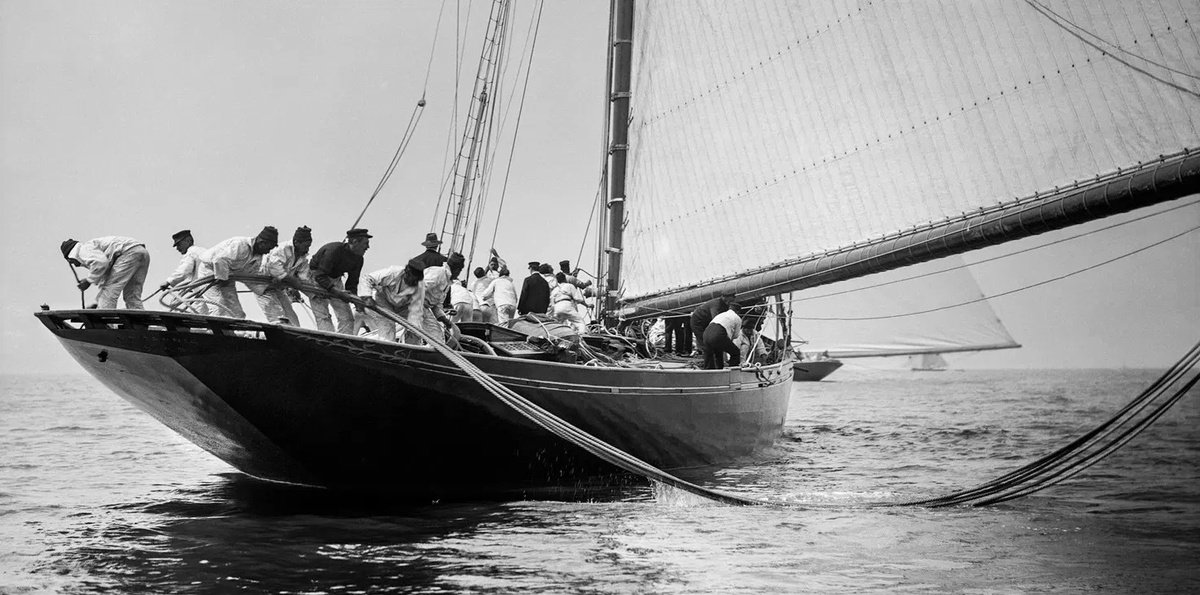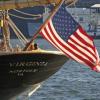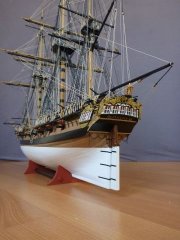-
Posts
231 -
Joined
-
Last visited
Reputation Activity
-
 Tim Curtis reacted to KeithAug in Altair 1931 by KeithAug - FINISHED - Scale 1:32 - schooner
Tim Curtis reacted to KeithAug in Altair 1931 by KeithAug - FINISHED - Scale 1:32 - schooner
Thank you Druxey.
Greg - thank you, good point.
Only a little progress today:-
I made the mounting feet for the crutch and attached it to the deck. The feet are quite small - a smidgen over 1/8 inch cube.
I also made the deck mounting for the "red duster". Made of two parts soldered together and machined.
And then polished
-

-
 Tim Curtis reacted to robnbill in Brig Eagle by robnbill - 1:48
Tim Curtis reacted to robnbill in Brig Eagle by robnbill - 1:48
Just an update on progress on the Eagle. I have been putting quite a bit of time into researching the rigging configuration for the model. Dr. Crisman has a fuzzy hand drawing of how he thinks the ship's Rigging Profile would have looked. For my purposes, I need to drill down to much further details. My model will not have sails but there will be a combination of standing and running rigging on the model.
I am using several references. The American ships were rigged following most, if not all the basic rules used for British Ship's of War. This makes things much cleaner. Given the expediency with which the Eagle was built (19 days) there were in all likelihood shortcuts in some of this. There certainly was with the hull construction. However, following these guidelines along with Crisman's expert opinions should give a good approximation of the ship as she sailed to battle. Here is a list of the reference material I am using in this effort.=
Crisman's The Eagle Steel's Elements of Mastmaking, Sailmaking and Rigging Lee's Masting and Rigging of English Ship's of War Lennarth Petersson's Rigging Period Ship Models David Antscherl's Swan Vol 4, Rigging a Sixth Rate Sloop (while much earlier than the Eagle, it is a valuable treatise on actually rigging a model The first order of business was to attempt to identify those lines shown in Crisman's drawing and record these on a new CAD drawing (I am attempting to do) of the rigged ship. I also had an email discussion with Ed Tosti asking his advice on approaching designing a detailed rigging profile. His sage advice was to develop a detailed spreadsheet that would capture all the lines as well as the details around them, i.e., size of rope, serving, color, blocks etc.
I found that the Petersson book was great in identifying lines typical to that period. I used this in conjunction with the Crisman drawing to develop a list of those lines I would be installing. This could then be cross referenced with the Steel and Lee volumes to flesh out the details.
One key aspect of this is deciding the size of the ship itself. Steel has a table for sizing ship's based on the number of guns on board. I will be using the 20 to 22 gun tables. There is a difference in line and block sizing between Steel and Lee. Steel's number tend to be slightly larger in both line circumference and blocks. However, there is also inconsistency in these tables that Lee's smooths out using common block sizing ratios. However, this does not answer which method to use. There was nothing left of the rigging in the wreck other than the lower chainplates and mast steps. However there was an inventory list for the supplies sold from Whitehall during the sell off of the Lake Champlain fleet and supplies in 1825. While circumstantial at best, it does point to those supplies that were common in the fleet. The sizes of running rigging and blocks falls more neatly into the Steel tables than Lee's So I feel comfortable using these.
I have compiled my list of lines, but have only started working on fleshing out the spreadsheet. This will be an on-going project I will be doing in conjunction with completing the masting and spars for the ship.
I had built a manual serving machine when rigging the Connie (1:92). However at 1:48 the Eagle will show much more detail in the rigging and require much more serving to be done than I wanted to do on my old manual machine. In preparation for this, I purchased Alexey Dumanoff's powered serving machine. It seems like a great machine and I can't wait to put it into service. It will be a great match for the Byrnes ropewalk.
I also have been putting in time actually making sawdust (and brass shavings). The photos below show the ship where she stands. I have been playing with my Grizzly Milling machine trying to develop the skills to actually use it well. More on that later. For this update, I used it to build the upper mast cheeks as well as sheave slots for the masts. The sheaves were turned on the lathe out of brass stock. I decided I did not like the previous iteration of the topgallant masts that I had done. On the Eagle, Crisman call for these to be exactly the same. So I redid these building them in parallel. These like all my masting were done first by cutting square strips of Maple to the size of the widest part of the mast, then using files, chisels and sand paper shaping the various sections per the drawings. By doing the fore and main topgallants at the same time I was able to better insure they were matched section by section. I still need to build the foremast cross trees and caps. The main mast caps also still require fitting and I may decide to redo some of those before all is said and done.
Anyway, that is where she is today. Once the foremast is complete, I will work my way through the bowsprit and jibboom, then the spars. At that point, I hope to have all the rigging spreadsheet filled out. This will give me a good estimate for the numbers and sizes of the blocks to be made as well as the inventory of rope I need to make prior to starting the rigging.
Here is a close up of the topgallant cheek blocks.
Topmast and topgallant masts. The fids will be cut to length after the cross tree is installed.Main mast topmast and topgallant masts.
Main mast topmast and topgallant mast
Main mast topmast and topgallant at cross tree.
-
 Tim Curtis reacted to KeithAug in Altair 1931 by KeithAug - FINISHED - Scale 1:32 - schooner
Tim Curtis reacted to KeithAug in Altair 1931 by KeithAug - FINISHED - Scale 1:32 - schooner
I had a go at the main boom crutch. On Altair this is a "A" frame - a rather crude affair which has the appearance of being made out of galvanised scaffolding poles. It is quite out of keeping with the other brass deck fittings. I couldn't bring myself to make a crutch that matched the original so I made something a little more in keeping. If I get a flood of derision from the purists among us I'll consider painting it grey.
The top bracket has a circular cut out in which the boom rests. I machined this out of bar on the mill. The web was formed by end milling using a rotary table.
The bracket was separated from the bar and then the legs were soldered on.
Cleaning up and polishing followed.
As a bit of a distraction I made and mounted the stern light.
I then made and attached the feet. The crutch lays flat on the deck and pivots up to the vertical when in use.
But of course not in the position shown in the photo.
Not sure I want to paint this!
-

-
 Tim Curtis reacted to vossiewulf in Lady Nelson by vossiewulf - Amati/Victory Models - 1:64
Tim Curtis reacted to vossiewulf in Lady Nelson by vossiewulf - Amati/Victory Models - 1:64
Thanks Popeye
And Rick, the reason I cut the scarf joint while planking the inside of the bulkheads is because I will be doing that joggling of the deck planks. I hope Tony is still listening, he did a pretty fancy job of the planking on his. I've got a good top view of a well-done Cheerful, if nothing else I'll just copy that here.
So we left off with the resolution of the Great Gunwale Debate, and BTW Rick haven't heard a peep back from Amati.
While we were arguing back and forth with that, I did the port-side rabbet for the second planking. If you remember I did the first primarily with my rotary tool, this time for safety's sake I decided to use edge tools and it was a good reason to use Mikhail's tools. People shouldn't see them as carving tools, more than half the set is straight and skew chisels and I'm sure he would sell a set of just those. All of the straight and skew chisel tools are fabulous micro-joinery tools.
First mark it out more carefully than the first one.
Cutting the top and bottom lines with Mikhail's knife.
Finishing with the same riffler I used before. This one seems specifically designed for model ship planking rabbets.
All was well on the bow end.
But as mentioned above, on the stern end the plans don't account for the thickness of the planking they told you to put on the transom, leaving it overhanging the rudder post where the final planking is supposed to end. So either we get a jaggy line or cut a piece of the rudder post out, I did the latter, starting with scoring the line.
And then I used Mikhail's straight and skew chisels to cleanly remove the required wood, and lemme tell ya cocobolo isn't the most carving-friendly wood.
Here I went back to the gunwale/bulkhead planking... what the hell are they? Both? Anyway the inner planking of the deck wall things
And Rick, the answer is cut those puppies into as many pieces as possible Well more accurately, fit and mark as one plank but I rapidly concluded that particularly working with a hard wood like boxwood that I would want to glue short pieces if possible and remove as much waste as possible before applying pieces to the model.
Here is another demonstration of my new tools, cutting a rabbet for inner bulkhead planking into a stem piece that's already installed.
I also want to know why, within ten minutes of sitting down in the shop area, my fingers always look like I've been fighting in Stalingrad for three weeks.
And successfully test-fitting a plank.
As mentioned, for practice I cut a scarf joint in one of the strakes, just eyeballing the first half.
Looks more or less right.
Clamp it and the other half down and mark it with a knife, pencils are way too fat for this.
Cut to the marked line, and theoretically it should be dead on.
Overall view of progress.
I am using my scraper to basically level each plank as it's glued on. Or you could wait to the end and try to level four boxwood planks at the same time. Your call
Rick was right, you do get some good ripple removal from the inner planking. But like everything there are limits and I'm still glad I spent time getting them as close as possible to right back when I did the original bending.
And as noted, it doesn't fix everything. This is one pernicious ripple that doesn't want to go away, highlighted in red.
I played around with clamping before glue, and glad I did as it had to be placed in exactly the right place to correct close the gap.
And now we have a completely fair line and no gaps and without any need for sanding or filling to get it that way, that makes me happy.
Obviously I'm leaving the openings somewhat rough until the outer planking goes on and we can finalize them. This is the stern area done, and I can only see one out of four glue lines and the fit with the fashion pieces looks good so overall happy.
And full view with port side inner planking done. The very top strake ended up with a visible line most of the way, not sure why, it looked as good as the rest dry fitting. But that's maybe a half star reduction, overall I'm pleased with the results, although this is as easy as planking gets. Proof will be in how I do with the bending and twisting of the outer planking.
-
 Tim Curtis reacted to KeithAug in Altair 1931 by KeithAug - FINISHED - Scale 1:32 - schooner
Tim Curtis reacted to KeithAug in Altair 1931 by KeithAug - FINISHED - Scale 1:32 - schooner
So to finish:-
The wheel hub on Altair is made of brass. I made my hub from the barrel of a redundant dart - turned down to 1/4 inch and drilled with 8 radial holes.
The spokes were coloured with wood dye and then assembled to join the hub and rim. The assembly was glued with CA.
The shaft (not yet finished) was turned from 1/4 inch brass rod. The wheel is teporarily attached to the pedestal. I still need to varnish the wheel.
The wheel is really quite fragile so I think I will have to store it away and only attach it as a final operation at the end of the build - still many months away.
-
 Tim Curtis reacted to 6ohiocav in US Brig Niagara by 6ohiocav - FINISHED - Model Shipways - Scale 1:64
Tim Curtis reacted to 6ohiocav in US Brig Niagara by 6ohiocav - FINISHED - Model Shipways - Scale 1:64
CLEWLINES AND SHEETS
While I have been working on prototypes of my scratch-build ship’s boats, I noted that we now have a new format to the site. Looks great. Thanks to the ADMINS. I can’t imagine the time it takes to keep all of this up to date.
Since I hit a snag on what to do with the clewlines and sheets for a ship rigged without sails, I broke down and secured a copy of Peterssons book “Rigging Period Ship Models” and found an answer in the diagram on page 49. Using that as a guide, I rigged my topsail clews and sheets. An adequate solution.
-
 Tim Curtis reacted to Brucealanevans in Charles W Morgan by Brucealanevans - FINISHED - Model Shipways
Tim Curtis reacted to Brucealanevans in Charles W Morgan by Brucealanevans - FINISHED - Model Shipways
I haven't posted progress because the foremast was just duplication of the mainmast yards, and I also took a week or so away to recharge. Having said that, I must be learning something from this process since the foremast went easier (altho the belay points were also more accessible, which helped.
Certainly doing the Morgan for my first truly rigged ship turned out to be a real challenge. Some bits don't bear real close inspection, some lines had to be spiced, etc. etc.
At any rate, the running rigging is now done except for the braces and placing rope coils. I expect that to take me a week or perhaps two. Then the Morgan goes into it's case in the living room while I build the whaleboats. Unless I add the cutting stage first.
-
 Tim Curtis got a reaction from aviaamator in La Jacinthe 1825 by aviaamator - 1:20 - schooner
Tim Curtis got a reaction from aviaamator in La Jacinthe 1825 by aviaamator - 1:20 - schooner
Aviaamator,
I too am praying for your recovery, and thinking of you and your children.
I love your beautiful Model. You are a wonderful craftsman.
Tim
-
 Tim Curtis reacted to popeye the sailor in Thermopylae by popeye the sailor - Sergal - 1:124 scale
Tim Curtis reacted to popeye the sailor in Thermopylae by popeye the sailor - Sergal - 1:124 scale
as you can see by my posting on a Sunday.......I did not go to work. I'm still battling the effects of the stomach bug. I won't go into too much detail.......distasteful as it is, let's just say, that after two days, I'm back up and running again.
the one good day I had did result in a bit of progress........the other day was spent at work on Saturday.......by the end of the day though.......I was hoping that the little blue pill I took, would wear off!. to dress up the pump, I ended up doing a few attempts, bending the shaft to accept the three connecting rods. I had drilled out the cylinders to give them more room.
when I had one that was reasonable enough, brass eye bolts were used as connecting rods.....a little tedious to get them all in order. it still needs to be trimmed.......but at least it is now assembled.
thanks for your patience.
-
 Tim Curtis reacted to EdT in Young America 1853 by EdT - FINISHED - extreme clipper
Tim Curtis reacted to EdT in Young America 1853 by EdT - FINISHED - extreme clipper
Young America - extreme clipper 1853
Part 201 – Lower Mast Coats
When I decided to wedge the masts with pieced wedges, it was clear that some sort of mast coats would be required to cover the openings between wedges – not to keep out water as in real life practice, but to simulate the real coats and to improve the appearance at the bases of the masts.
Apart from terse descriptions, there was not a lot to go on in making these. My usual search through photos gave some ideas, but ultimately the solution came from the question, "What would I do to make a watertight canvas 'flashing' over the mast wedges?" I am comforted by the thought that many ships' carpenters asked similar questions – and came up with a variety of solutions - as the few pictures I have seen illustrate.
The canvas for the model coats is tissue and in the first picture a strip of this is being wound around the glue-coated main mast and its wedging.
Several strips were used with plenty of glue and not too much effort to smooth out the result. Canvas would most definitely have wrinkles when forced into the required shape. The next picture shows rope being tied around the top to clinch it tightly around the mast.
In practice the coat would have been caulked and tacked around the mast and deck, but rope cinches would keep it from tearing out from the nails and risking damage to the high-value cargo these ships often carried.
At the bottom, a flange was simulated using card and fitted around the mast at the base as shown in the next picture.
When this was glued in place and allowed to dry, a second rope cinch was added at the base. The next picture shows the coat being "tarred" with fairly thick, dark grey, artists' acrylic paint,
After drying the coat was brushed with black, thinned, acrylic wash to highlight the wrinkles in the canvas and the ropes as shown below.
Those that have been following the project will note that the glistening brass pump wheels, by now well tarnished and lacking their original appeal, have been painted. Next job for the painters, the equally tarnished poop monkey rail.
Other true followers may also notice in the picture that I have finally gotten around to adding the central posts to the fore and aft fife rails that were previously omitted.
Ed
-
 Tim Curtis reacted to Barbossa in HMS Diana By Barbossa - Caldercraft - Scale 1:64 - The 1794 Attempt
Tim Curtis reacted to Barbossa in HMS Diana By Barbossa - Caldercraft - Scale 1:64 - The 1794 Attempt
Here's part II
Last pic is dedicated to 1) MSW Staff : congrats regarding the software update and Ray : consulting his buildlog (HMS Diana fvinished +/- a year ago) made things more easier and comprehensable., Cheers Ray
-
 Tim Curtis got a reaction from VACorsair in Scottish Maid by Tim Curtis - FINISHED - Artesania Latina - Scale 1:50
Tim Curtis got a reaction from VACorsair in Scottish Maid by Tim Curtis - FINISHED - Artesania Latina - Scale 1:50
Finished planking the ship's boat.
Quite fiddly. Used a little filler to smooth things off.
But pleased how its turned out. Its a small boat to plank!
-
 Tim Curtis got a reaction from kier in Scottish Maid by Tim Curtis - FINISHED - Artesania Latina - Scale 1:50
Tim Curtis got a reaction from kier in Scottish Maid by Tim Curtis - FINISHED - Artesania Latina - Scale 1:50
Hi Pavol.
Here you go.
Tim
-
 Tim Curtis got a reaction from John Allen in Scottish Maid by Tim Curtis - FINISHED - Artesania Latina - Scale 1:50
Tim Curtis got a reaction from John Allen in Scottish Maid by Tim Curtis - FINISHED - Artesania Latina - Scale 1:50
Hi Pavol.
Here you go.
Tim
-
 Tim Curtis got a reaction from hexnut in Scottish Maid by Tim Curtis - FINISHED - Artesania Latina - Scale 1:50
Tim Curtis got a reaction from hexnut in Scottish Maid by Tim Curtis - FINISHED - Artesania Latina - Scale 1:50
Also. Here is another photo of the fore top with iron sling and toprope attached. Paintwork needs tidying.
-
 Tim Curtis got a reaction from hexnut in Scottish Maid by Tim Curtis - FINISHED - Artesania Latina - Scale 1:50
Tim Curtis got a reaction from hexnut in Scottish Maid by Tim Curtis - FINISHED - Artesania Latina - Scale 1:50
Finished planking the ship's boat.
Quite fiddly. Used a little filler to smooth things off.
But pleased how its turned out. Its a small boat to plank!
-
 Tim Curtis got a reaction from VACorsair in Scottish Maid by Tim Curtis - FINISHED - Artesania Latina - Scale 1:50
Tim Curtis got a reaction from VACorsair in Scottish Maid by Tim Curtis - FINISHED - Artesania Latina - Scale 1:50
Hi Pavol.
Here you go.
Tim
-
 Tim Curtis reacted to giampieroricci in L'Amarante 1749 by giampieroricci - FINISHED - 1:30 - French Corvette
Tim Curtis reacted to giampieroricci in L'Amarante 1749 by giampieroricci - FINISHED - 1:30 - French Corvette
I had forgotten some details:
I also started building small boat:
-
 Tim Curtis reacted to Brucealanevans in Charles W Morgan by Brucealanevans - FINISHED - Model Shipways
Tim Curtis reacted to Brucealanevans in Charles W Morgan by Brucealanevans - FINISHED - Model Shipways
Finished the cutting in stage today.
The Morgan (ship) is done.
I'll put it somewhere safe and begin working on the whaleboats. Since I've been ignoring other projects and interests to push to get to this stage, I'm going to limit myself to mornings in the shipyard till the whaleboats are done and mounted.
Here's the cutting in stage:
-
 Tim Curtis reacted to Brucealanevans in Charles W Morgan by Brucealanevans - FINISHED - Model Shipways
Tim Curtis reacted to Brucealanevans in Charles W Morgan by Brucealanevans - FINISHED - Model Shipways
Running rigging is now done.
New candidate for repetitive mindless job of the month: making dozens of rope coils for the belay point (last picture).
The rest are views of the essentially complete Morgan with coils for the spider bands and mainmast pinrail yet to be placed. I was hoping to be completely done (except the 7 whaleboats) before I leave the country for a week, but the coils took longer than expected and I won't have time to do the cutting-in stage and the paint touch ups here and there that it needs.
Only a day or two work remaining.
-
 Tim Curtis reacted to Stuntflyer in HM Cutter Cheerful 1806 by Stuntflyer (Mike) - FINISHED - 1:48 scale
Tim Curtis reacted to Stuntflyer in HM Cutter Cheerful 1806 by Stuntflyer (Mike) - FINISHED - 1:48 scale
Well, I'm happy to say that the ratlines are done. The next step will be to complete the standing rigging and add some rope coils. Getting there!
Mike
-
 Tim Curtis reacted to popeye the sailor in Thermopylae by popeye the sailor - Sergal - 1:124 scale
Tim Curtis reacted to popeye the sailor in Thermopylae by popeye the sailor - Sergal - 1:124 scale
I have an idea as to what I want to do with the roofs. for the galley roof, it was bordered off with mahogany.....even around the skylight. I still need to fill in the front walls and the companionway, but the roof is a good start. the skylight opening was made larger, and the inside will be painted. I'm planning to use window maker for the glass, so it will be clear. there won't be much to see anyway, but the trouble will be worth it.
-
 Tim Curtis reacted to donrobinson in Barque Stefano by donrobinson - MarisStella - 1:63
Tim Curtis reacted to donrobinson in Barque Stefano by donrobinson - MarisStella - 1:63
Hello All, Thanks for stopping and for your likes and comments.
Well a week has gone by and I don't have that much to show, For some reason I thought I would have had lots more to show, but I have started on the planking and all is going smooth. At this stage Stefano is 810 mm long so I suppose this is maybe why it is going slower than I thought. No matter there is no rush. The transom has proven to be a little bit of a hair puller outer but fortunately with my already thinning hair there was not much to grab onto and all worked out
The first row of planking installed at top of bulkheads, no tapering done on this strake. The bulkhead extensions are to be removed later on, therefore there is little glue applied to these points of contact with the planks. It is necessary then to pay special attention while installing the first four strakes and be sure there is adequate glue applied to their edges and proper clamping is applied.
The new shipyard aka dining room
And here Stefano is beside the Pegasus, the Pegasus is 500 mm in this picture 310 mm shorter than the Stefano. Pegasus is 1:64 and the Stefano is 1:63
This week is the Trabaccolo,
See You All Later







